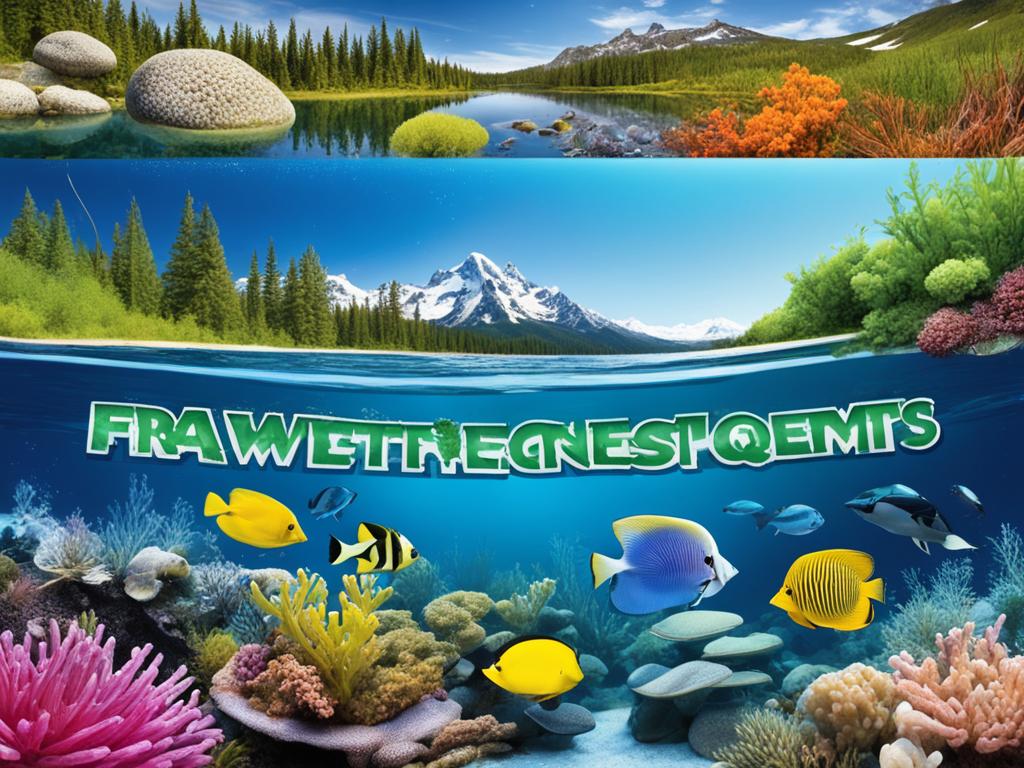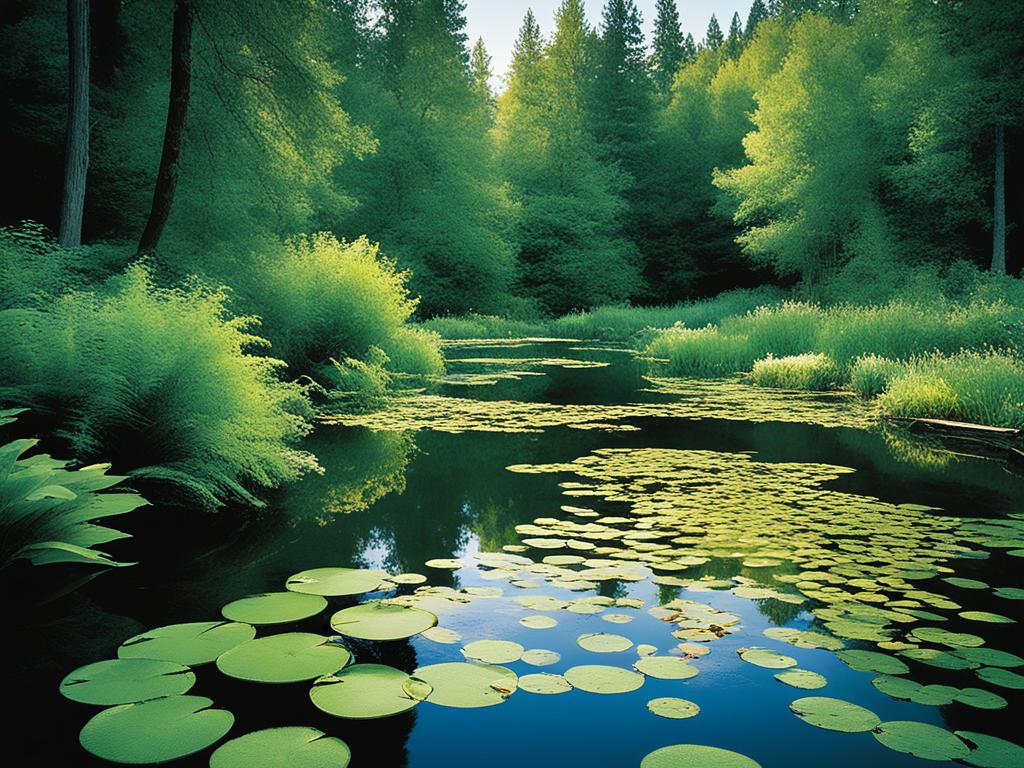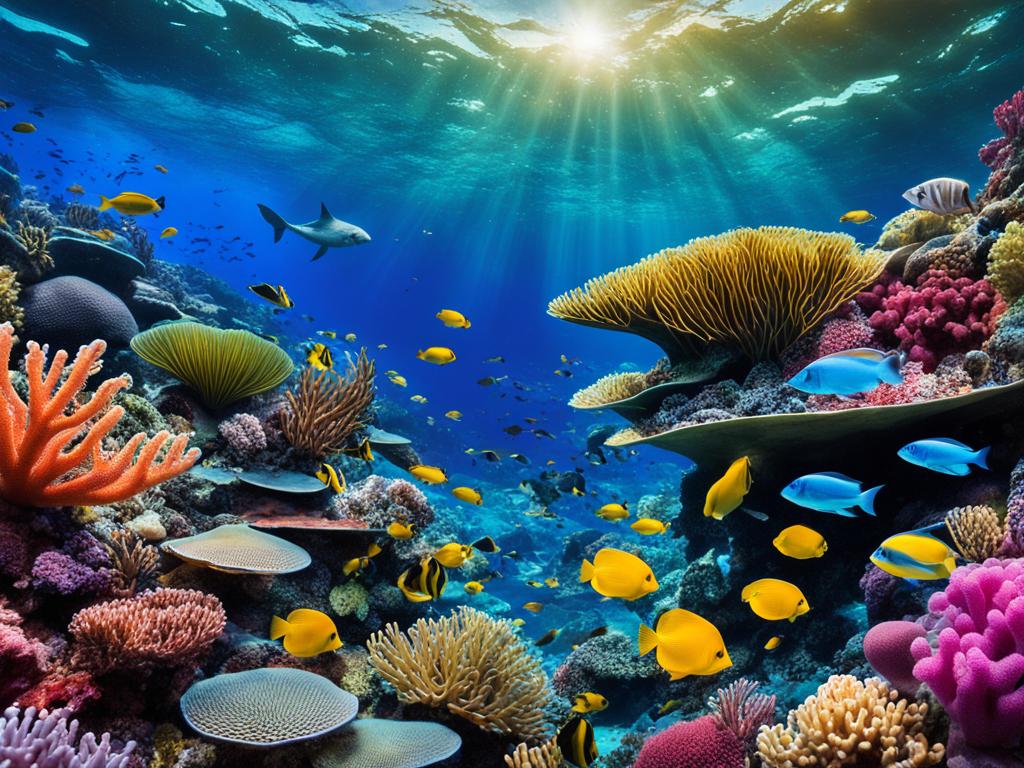Aquatic ecosystems occupy an amazing 75 percent of the Earth’s surface. They are mainly split into two types: freshwater and marine ecosystems. Freshwater areas like ponds, lakes, rivers, and streams have a low salt content, usually under one percent.
On the other hand, marine environments include the vast oceans and seas. They cover large parts of the Earth and have a lot of salt. The movement and depth of water in these places greatly affect the living things that call them home. In shallow waters and deeper areas, different species thrive by adapting uniquely.
Coral reefs and estuaries are special places where freshwater and saltwater life mix. They show how both freshwater and marine ecosystems can combine and create rich biodiversity.
Key Takeaways
- Aquatic ecosystems cover 75 percent of the Earth’s surface.
- Freshwater ecosystems include ponds, lakes, rivers, and streams with low salt content.
- Marine ecosystems cover large areas and have high salt concentrations.
- The depth and movement of water influence organism adaptations.
- Coral reefs and estuaries exemplify biodiversity intersections.
Introduction to Aquatic Ecosystems
Aquatic ecosystems are diverse watery worlds, each defined by its salt levels. They include freshwater vs. marine environments. Both types are crucial for the planet’s ecological balance.

Studying these watery worlds are limnology and oceanography. Limnology looks at freshwaters like ponds and rivers. Oceanography explores oceans and seas. They help us understand aquatic biomes.
Freshwater places stand out with still and flowing waters, such as lakes and rivers. They differ from the ocean in salt levels. This affects the life found there and their survival methods. Limnology helps us get these insights.
Marine environments spread over oceans and seas. Here, oceanography steps in. Animals and plants in these places adapt to more salt. Research highlights their importance for clean water and helping species adapt.
Knowing about freshwater vs. marine environments shows their part in nature’s balance and richness. Limnology and oceanography keep revealing the wonders of these vital places.
- Freshwater Bodies: Ponds, lakes, rivers, streams
- Marine Environments: Oceans, seas, estuaries
| Ecosystem Type | Salinity | Examples | Field of Study |
|---|---|---|---|
| Freshwater | Ponds, lakes, rivers | Limnology | |
| Marine | 3.5% on average | Oceans, seas, estuaries | Oceanography |
Characteristics of Freshwater Ecosystems
Freshwater ecosystems include lakes, ponds, rivers, and streams. They have low salt content. These places are key for many living things that need specific water conditions to survive. They add a lot to Earth’s diversity and offer vital services like cleaning water and giving homes to different species.

Water Quality in Freshwater Ecosystems
The quality of water in freshwater habitats is very important. It keeps the ecosystem balanced. Things like temperature, how acidic or basic the water is, and nutrients in the water affect the health of these places. Too many nutrients can cause too many algae to grow, which is bad for water quality and living things in the water. It’s important to keep an eye on these places to protect them.
Diversity in Freshwater Habitats
Freshwater places have a wide range of living things. From tiny organisms to big fish like trout, which manage water in their bodies very well. Changes in temperature and what nutrients are available can change what lives in these habitats. Places like wetlands, rivers, and lakes have different plants and animals, making each spot unique. These areas are important because they support diversity and provide essential services like preventing floods, recharging groundwater, and being places where people can have fun.
| Key Factor | Importance |
|---|---|
| Water Quality | Determines the health and sustainability of the ecosystem. |
| Biodiversity | Supports a wide range of organisms and maintains ecological balance. |
| Eutrophication | Can degrade water quality and negatively impact aquatic life. |
| Ecosystem Services | Includes water purification, habitat provision, flood control, and more. |
Characteristics of Marine Ecosystems
Marine ecosystems are known for their high salt levels. They provide a complex and varied home for many organisms. Here, creatures show amazing adaptations to deal with different temperatures, saltiness, and nutrient availability.

Marine Biodiversity and Adaptations
The idea of marine biodiversity covers the vast range of life in these waters. For example, fish have special gills to deal with salt. These special features help them live in certain areas, keeping the ecosystem balanced.
Unique Marine Structures: Coral Reefs and Estuaries
Coral reefs are key spots for marine life. They’re full of fishes and corals, providing places to live, eat, and grow. Yet, these reefs face dangers from climate change, pointing to the urgent need for protection.
Estuaries are where rivers and oceans mix. They’re crucial for birds and fishes that migrate. These places merge fresh and salt water, giving support to diverse marine life. Estuaries are key for protecting the variety of life in our seas.
Aquatic Ecosystems: Freshwater vs. Marine Environments
Comparing freshwater vs. marine environments shows us big differences. Freshwater areas have little salt and include rivers and lakes. They are home to creatures that need these conditions. Marine ecosystems, on the other hand, have a lot of salt. They cover large areas like oceans and seas and are filled with a wide range of life.
| Aspect | Freshwater Ecosystems | Marine Ecosystems |
|---|---|---|
| Salinity | Low (typically less than 1%) | High |
| Biodiversity | Species like freshwater fish, amphibians | Species like marine fish, coral, cetaceans |
| Ecological Services | Water purification, habitat for numerous species | Carbon sequestration, nutrient cycling |
| Habitat Conservation | Involves protecting rivers, streams, and lakes | Involves protecting coral reefs, estuaries, and oceanic regions |
Both freshwater and marine environments are key for biodiversity and ecosystems services. They each have special roles that help the planet. To keep them safe and balanced, we need to recognize their unique needs. Protecting these places is critical. It helps maintain the balance of nature and supports various life forms.
Threats and Conservation Strategies
Aquatic ecosystems face many dangers. These include pollution, habitat loss, and climate change effects. They challenge the balance of nature and the variety of life.
Pollutants and plastics spoil the water, harming both sea creatures and people. Cities expanding also destroy natural homes for many species.
To protect these water worlds, we need strong plans. Rules must limit harmful waste and manage how land is used near these areas. Fighting pollution is key, like cutting down on plastic use and cleaning wastewater better. Plus, taking steps to reduce climate change is critical for the environment’s future.
Keeping an eye on the environment helps a lot. We need to keep track of water quality, animal numbers, and how the climate is changing. This lets us act fast to protect these precious places. Using high-tech tools and bio-monitoring makes this task easier. With smart and coordinated efforts, we can save our aquatic friends and their homes.


